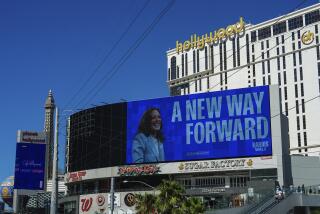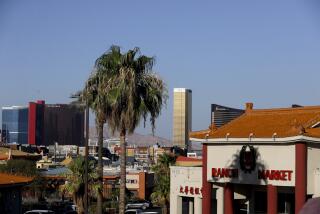Sin City Inc.
- Share via
-----
Sharks in the Desert
The Founding Fathers and Current Kings of Las Vegas
John L. Smith
Barricade Books: 400 pp., $24.95
-----
In the Desert of Desire
Las Vegas and the Culture of Spectacle
William L. Fox
University of Nevada Press: 186 pp., $24.95
ANY doubt that Las Vegas has become America’s mainstream cultural capital -- the city that best embodies the nation’s corporate ethos -- evaporated this year when the town was neatly chopped (as they say at the poker tables) between two behemoth corporations: Kirk Kerkorian’s MGM Mirage acquired the Mandalay Resort Group and Harrah’s Entertainment bought out Caesars Entertainment, thus becoming the largest casino company in the world. The two gambling titans now own almost every major property on the fabled Strip, the main attraction in a city that draws nearly 40 million tourists a year. The notable exceptions, Steve Wynn’s Wynn Las Vegas and Sheldon Adelson’s Venetian, are themselves part of multibillion-dollar publicly traded corporations. Tax receipts from the newly aggregated MGM Mirage and Harrah’s alone now account for almost a third of Nevada’s general fund revenue.
As the desert metropolis celebrates its centennial this year, it has completed its transition from a Sin City run by gun-toting mobsters to a New Las Vegas run by risk-averse Bluetooth-equipped MBAs. “Consolidation was the way of capitalism, and the gaming industry practiced that philosophy at hyperspeed,” writes John L. Smith in “Sharks in the Desert: The Founding Fathers and Current Kings of Las Vegas.”
A respected columnist for the Las Vegas Review-Journal and author of several books on his hometown (including an acclaimed biography of Wynn), Smith has compiled an entertaining series of meticulously researched sketches on just about everyone who has ever owned a casino there. What makes his juicy, almost surreal tales of Vegas’ founding fathers (roll over, Tom Jefferson!) so engrossing is that for decades, as Smith reminds us, this neon island in the desert was the only place in America where it was legal to be illegal. Indeed, Benny Binion, the founder of Fremont Street’s legendary Horseshoe casino, must be the only multiple killer in U.S. history memorialized by a bronze statue of himself on a horse. “Men considered not only notorious but deadly in other communities had evolved into colorful characters in Las Vegas,” Smith writes. “Binion admitted killing three men, was suspected of ordering several other murders, and had maintained a decades-long relationship with organized crime, but on Fremont Street, he was a gregarious cowboy gambler who allowed customers to play with as much cash as they could carry into the Horseshoe.”
Countless other reprobates laundered themselves in the desert sun, most famously Bugsy Siegel. There was also Moe Dalitz, who came to Las Vegas from the Cleveland mob, partnered with the Teamsters Central States Pension Fund, created the lavish Desert Inn, backed a couple of other such “carpet joints” on the Strip and then went on to build the city’s first full-service hospital and become a venerated philanthropist and B’nai B’rith man of the year.
The most richly detailed portraits in “Sharks in the Desert” are of the city’s two contemporary mega-players, Kerkorian and Wynn -- the men most responsible for the accelerated modernization and corporatization of America’s gambling mecca. Kerkorian, a reclusive but driven tennis-playing octogenarian, has on three occasions in Vegas history built the largest hotel in the world. He now controls a dozen casinos on or near the Strip and heads a $9-billion empire.
Wynn, for his part, revolutionized the casino industry in 1989, when, financed by Michael Milken’s junk bonds, he opened the spectacular Mirage and proved that gambling resorts could make as much money, or more, from the shows, shops, restaurants and meeting rooms as from the slots and the card tables. Five years ago, Wynn suffered a humiliating blow when he was forced to sell his Strip holdings to Kerkorian. Now he’s back, with the Wynn Las Vegas. Only in the corporate-bloated America of 2005 could his $2.7-billion property be seen as David to Kerkorian’s Goliath.
Smith clearly delineates the supine posture assumed by Nevada authorities and regulators, who tolerated not only the unsavory casino operators of the Siegel-Dalitz era but also some of the slippery corporate shenanigans of the present. It’s no accident that Vegas today enjoys what the pols like to call “broad bipartisan support”: Local county commissioners and city council members accept paid consultancies from the casinos, while in Washington the industry is aggressively represented by Nevada Sen. Harry Reid, the Democratic minority leader. The head of the casino trade association, meanwhile, is Frank Fahrenkopf Jr., an influential former chairman of the Republican National Committee.
THERE are two key contextual issues that Smith’s book overlooks: Just what were the powerful economic currents that made the corporate transformation of Las Vegas inevitable? And what is the magic mass intoxicant that has made this city the nexus of so many superlatives: the fastest-growing, the hottest, the biggest, the best?
William L. Fox takes on the second question in his delightfully written “In the Desert of Desire: Las Vegas and the Culture of Spectacle.” Fox is described on his book jacket as an “independent scholar, cultural geographer, essayist, poet and travel writer,” so you know right away that this narrative will not exactly be linear. And it isn’t. How could it be, when it concerns “the presentation of art, animals, and sex in American society as seen through that very peculiar filter, the Las Vegas Strip”?
As I tagged along on his zigzagging explorations of Steve Wynn’s $300-million art collection, the local public art museum, the Guggenheim-Hermitage gallery inside Adelson’s Venetian, through the Mirage’s “dolphin habitat,” out to the bare-bones Vegas public zoo and then into Cirque du Soleil’s steamy stage production of “Zumanity,” I felt the exhilarated giddiness of one of those long, winding nocturnal rambles through the Strip itself.
What Fox discovers is hardly earthshaking: The awesome, glaring, for-profit entertainments overpower the city’s more sedate educational and public institutions. In other words, people come to Las Vegas not to stroll through its art museum or feed the furry critters at the zoo but to gawk at and mix it up with the city’s real wildlife: the world-weary dealers, the strung-out losers, the slot addicts, the bosomy waitresses, the undulating lap dancers.
“What’s being sold?” Fox asks in his preface. He provides several answers, foremost among them “spectacle” on a scale never before seen in history. “You can order up whatever spectacle you can afford, a pay-as-you-play paradise,” he writes. “Las Vegas enables you not only to gaze upon spectacle but also to sleep in its bed and have sex with it.”
Part of Las Vegas’ heady allure is the promise of intimate association with the greatest of all aphrodisiacs -- power. With grudging admiration for Wynn’s chutzpah, Fox points to the casino mogul as one of its master practitioners, noting that Wynn got the Nevada Legislature to underwrite his vast private art collection, which he exhibited in one of his hotels: “So Wynn buys the art and is exempt from the tax for owning it. He leases it to the hotel, which earns more than enough in admissions to pay for the operating costs of the gallery. When he sells the art, he’s exempt from most of the sales tax....” Of the Mirage’s dolphin habitat, he remarks: “The unexpected juxtaposition of desert and dolphins implies the wealth and power necessary to produce such a sight, which creates the spectacle that Wynn wanted: a display of how he [had] the resources to overcome the conventions of geography, just as he [did] with tax laws.”
Fox is no simple scold. Aware that the line between public and private cultural spaces is erased faster in Las Vegas than anywhere else, he argues that this city is precisely where some sort of positive synergy between the two exists. The Shark Reef at the Mandalay Bay hotel is up to or even beyond the standard of any public aquarium. And although the exhibits at the Venetian’s Guggenheim-Hermitage gallery help attract new players to the casino, tens of thousands of casino patrons are also exposed to art they presumably would otherwise never seek out. Many visitors, Fox says, are apt to ask whether all those paintings are “authentic.”
Authentic or not, it hardly matters in Vegas. Things move too fast for anyone to figure such things out. The 100-year-old city is sprouting a bumper crop of high-rise luxury condos. A few blocks off the old Strip, a second one is emerging, on which actor George Clooney and his partners aim to build a $3-billion resort with an upscale dress code, no less. And Kerkorian’s MGM Mirage has announced the ultimate breakdown of the public-private barrier: a “Project CityCenter” that will construct a private metropolis inside the existing urban core. To be built on 66 acres, the CityCenter will offer half a million square feet of shops, an entrance on the scale of Fifth Avenue, a 4,000-room resort casino and 1,500 luxury residences for those who can afford to live in the city within the city, and who will probably never once ask themselves which one is authentic. *
More to Read
Sign up for The Wild
We’ll help you find the best places to hike, bike and run, as well as the perfect silent spots for meditation and yoga.
You may occasionally receive promotional content from the Los Angeles Times.






